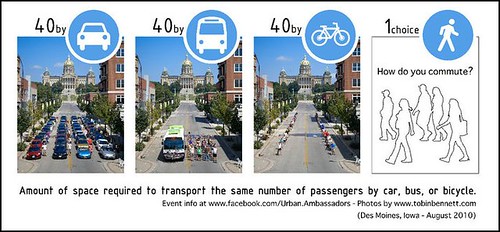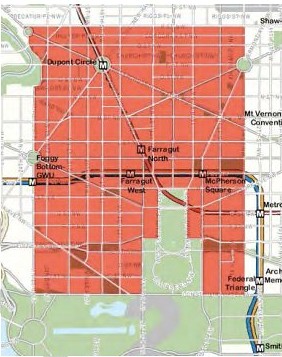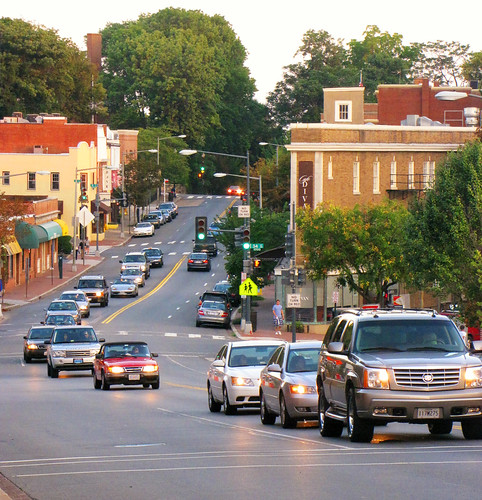Sortation: If you don't get it, you don't get it: more on car culture and automobility and Ward 3

So the January 16th Northwest Current has an editorial, "Striking a balance," about the approval of plans for a 60 unit apartment building in Tenleytown with a smattering of retail and more importantly, no parking (well, one spot). (For more on the project, see "No Parking: Zoning Commission Approves The Bond at Tenley"" from DC Urban Turf.)
There has been a lot of opposition to the project, even though it is located a few hundred feet from the Tenleytown Metro Station and on one of the city's most frequent and highly ridden bus lines, because for the most part, they can't imagine some people being able to live generally (and in Ward 3) without owning a car.
From the editorial, which extends the discussion to proposed changes in zoning regulations that will eliminate parking minimums for multiunit buildings located in transit rich parts of the city:
We agree that less parking is needed in such areas, but eliminating the requirements goes too far. 'If you don't build it, they won't come by car' just doesn't work as a precept. It's clear that many people find it perfectly convenient to live without a car, but others consider automobile ownership essential to their way of living. ...

The point is to attract more people to the city to live and work who consider walking, biking, and transit and membership in car sharing services as more "essential to their way of living," rather than to take on all the costs of servicing people who consider automobile ownership essential to their way of living.
(This is not dissimilar from discussions about how the city should be focusing on attracting families, without recognizing that it costs at least $15,000 per year on average to educate each school aged child in public schools, and that this amount tends to be greater than the tax revenues generated by typical city households. We need similar figures about how much it costs to maintain the road system, parking, etc.--recognizing that the roadway network benefits all of us in many ways, whether or not we use it to drive cars we own or cars we don't own.)
DC was never designed for the car.
In fact its design was set during the Walking City and Transit City eras (from before 1800 to 1920). In the beginning people walked or rode horses/carriages. Horse-drawn trolleys came about in the 1860s, and electric or cable streetcars in the 1880s.
That doesn't mean that cars aren't accommodated, and the reality is that cars are prioritized in the city's transportation policies.
But space-wise, it's much more efficient to get people to the city, around within the city, and out of the city by higher capacity modes (transit) complemented by space-efficient modes (walking and biking), further complemented by "assistance devices" (delivery services, car sharing) that enable living without "having" to own a car.

Left: amount of space required for surface parking to service the number of people moving in and out of the city's core by transit. Image from the WMATA Strategic Plan.
In short, in the space of 3 cars you can fit one bus. (This doesn't even take into account subway cars, which hold more than double the number of people on a typical bus.)
The bus likely has 30-60 passengers, while the three cars have 3-5 passengers. To move the same number of people on the bus in cars instead, you need at least 45 cars, which takes 15 times the amount of space in the travel lanes, but also have to be parked and therefore space for parking needs to be provided at most possible points along their journeys.
It's not a war against cars, but a question of physics.
Interestingly, the same issue of the Current has other stories, "Local author espouses benefits of walkability," a discussion with local resident Jeff Speck and his new book, Walkable City: How Downtown Can Save America One Step at a Time" (a big part of Speck's book is how prioritizing and privileging car use induces demand) and a review of new condos available at CityCenterDC, a new development about 2 blocks from Gallery Place Metro and about 3 blocks from Metro Center, that fundamentally, are about a lifestyle that de-emphasizes the "necessity of having to own a car."
Again, if car owners were really out for the own interest, they would be encouraging car lite lifestyles as much as possible, in order to enjoy an automobile-centric lifestyle with fewer people competing with them for the use of scarce street and parking resources.
This gets back to arguments I used to make 10 years ago, that the point of urban revitalization for Washington, DC wasn't to make over the city to appeal to suburbanites, it was to strengthen and extend those qualities that make the city unique and attractive and appealing ("urban") to those people who want to live in a city/urban place as opposed to "the suburbs" (which are not monoculture either, but that's another argument).

Right: Wisconsin Avenue by vpickering, on Flickr. This is Upper Georgetown, not Tenleytown, but the road conditions are similar.
Labels: car culture and automobility, land use planning, parking and curbside management, transportation planning, urban design/placemaking, zoning



13 Comments:
It was an editorial. Are residents not allowed to have and write about divergent views. From the outside looking in, I would say that it is the no "cars" crowd that is getting more and more 'cult like' daily. Are you really disparaging the NW Current for publishing an opinion piece? Maybe the editors should start having you vet all the publication for suitability to our fragile non thinking minds.
"It's clear that many people find it perfectly convenient to live without a car, but others consider automobile ownership essential to their way of living."
Correct. And people who consider automobile ownership essential can simply choose not to live in that particular building. Many other people do not consider automobile ownership essential. Is the Current arguing that the automobile dependent are somehow more worthy of consideration when it comes to the planning and design of every new building in the city?
As for disparaging the Current -- Richard is not disparaging them for running an opinion piece. He is disagreeing with their opinion. Am I to understand that the editors of the Current are infallible beings whose opinions cannot be challenged?
I didn't read anything in that piece that gave me the impression that Richard was disparaging anyone's opinion. Merely seems like a counterpoint to the Current's position. Me thinks you're getting a bit defensive, Anonymous.
editorials have the "word of god" behind them. They aren't "opinions" so much as they are positions. Newspaper editorials tell people, including elected officials, "hot to think."
FWIW, I thought it was not well argued.
Richard, I appreciate your efforts to "think" like a car-owner in DC and expand your mind a bit.
However, I think your planner DNA is coming to the fore here.
DC isn't designed for cars? No, the L'enfant city wasn't, but thank to overly wide streets it made it very easy to adapt to car in the past 90 years. Ward 2 and 3 were built for cars.
And let's be honest -- the reasons why the good citizens of Ward 2 and 3 don't want more density are far more complicated than more traffic. It is more of a externality argument. And they are not getting good, high quality transit -- and TOD -- anytime soon.
As we've discussed before, when you build luxury units at 600K, they will come with cars. The key is keeping that to one car per unit, and reducing multiple car ownership per household.
But the
Wards 2 and 3 were designed for cars? Really? The Chevy Chase Land Company build bridges and a streetcar line to bring people in and goods out to the neighborhoods, including Chevy Chase and Cleveland Park. Ward 2, like Dupont Circle and Georgetown? Those neighborhods predate automobiles.
Yes, the interests of Ward 3 residents who are vocal supporters of the status quo seem to want to keep their schools for themselves and are more akin to residents of Loudon County than Shaw. It is pretty sad.
Also, a $600,000 residential unit need not necessarily have a parking spot to be viable. That is the myopic view of "charlie" speaking. If a developer didn't think their project was viable, if a lender were not willing to lend the money for such developments, we might be engaged in a different conversation. However, both the developer and lender are willing to risk their resources for the sake of the viability of the project. The neighborhood seems to have strong safeguards against parking impacts, so it would appear to be a win for all - except for those who prefer a black concrete husk on Wisconsin Avenue.
WRT rg's point:
Is the Current arguing that the automobile dependent are somehow more worthy of consideration when it comes to the planning and design of every new building in the city?
Yes, the Current is arguing that the automobile dependent are more worthy of consideration and that the decision to reduce automobile accommodation in buildings is very very very very very very bad, but worthy of consideration sometimes.
cf. http://www.google.com/imgres?imgurl=http://neilrolde.files.wordpress.com/2012/05/public-domain-american-way-p3.jpg&imgrefurl=http://neilrolde.wordpress.com/category/national-politics/&h=391&w=685&sz=62&tbnid=9xPAO-wUYbi7hM:&tbnh=70&tbnw=122&zoom=1&usg=__loiIolKdrOhStsgcETv1Ro2Hu00=&docid=rBvpp1MN3drKaM&hl=en&sa=X&ei=YZ0GUZSZO4eL0QG72IG4AQ&sqi=2&ved=0CDgQ9QEwAg&dur=541
Charlie, two things. First, you're absolutely right that high income households are far more likely to have cars than not.
So the people attracted to "expensive" housing in W2 and W3 are more likely to have cars, although I would argue that they are a bit less likely to do so, depending on where they are located in what we might call the "car light lifestyle opportunity zone."
Second, I guess I don't fully explain what I mean when I say that the city wasn't built for cars, because while I include the road network a bit in this broad statement (and yes, L'Enfant's wide streets enable wide roads), really what I am referring to more is the potential "storage capacity" on site and off site (on the street) for cars, especially in attached housing neighborhoods (R4).
And even in the denser parts of Ward 3 such as Chevy Chase and Friendship Heights, there is limited capacity for storage of cars _on site_. So most people park on the street.
If I get into too much detail I start sounding pedantic and I don't want to appear to be lecturing you, as you are fully conversant with the details.
In short, it's not possible to provide car storage space on the street for all houses on a lot in an R2-R4 zone, let alone multiple cars per household.
This is true for single family dwellings, attached or not, depending on the area.
So yes, much of the opposition to eliminating parking requirements on new construction arises because residents in those neighborhoods already recognize the capacity constraints and they don't want new entrants coming in and competing for these scarce resources.
Some neighborhoods have on site parking capacity, like mine, although many houses/lots are not set up to avail themselves of this. On my block probably 90% of the households regularly park on the street.
And even houses in some neighborhoods--I don't know what you call the area east of 5th St. around Gallatin etc. I guess Petworth still, while the rowhouses there were often built with rear entry garages, these garages are not large enough for the automobiles of today (with the exception probably of the SmartCar only).
So in most neighborhoods in much of the city, people "have" to park on the street.
Does this better explain what I mean when I make that broad statement?
Basically in a rowhouse neighborhood, except for the corner houses, which have a side, there is enough space in front of a house for one car...
In Chevy Chase, on the street, the houses/lots are wider, but the houses are packed in, and I don't imagine there is much more capacity than 2 cars in front of each house, eased a bit with rear access parking.
SO this is why I argue that car ownership reduction strategies ought to be welcomed by everyone, especially car owners.
... although the AAA gets up in arms about traffic throughput which is another issue, because they don't like lanes "being taken away" from predominately motor vehicle traffic.
E.g., while they bitch and moan about bike lanes, they probably would be almost equally argumentative about dedicated transitways.
This sentence has a big error...
In short, it's not possible to provide car storage space on the street for all houses on a lot in an R2-R4 zone, let alone multiple cars per household.
It should be this
In short, it's not possible to provide car storage space on the street for all houses on a block in an R2-R4 zone, let alone multiple cars per household.
Charlie, on my block there are 32 houses. The corner houses do not have rear access. Typically those houses were built with garages or even basement side entry garages.
One corner house uses the on lot
driveway (but not the garage). Two other houses always use the rear for parking. But one is because they have a car not registered in DC and they don't want to have to deal with regulations about registering vehicles in DC. A tenant in another house does off street parking (but on the block across from us) for the same out of state registration reason--but the house owner parks on the street. (Our zoning is R1.)
... oops (hit return too soon).
If this were a typical suburban neighborhood block all of the houses would have curb cuts and front entry driveways and either separate garages or garages built into the footprint of the house.
Not that you care, but, there are 32 houses on my block. 3 corner houses and 1 more house don't have alley access. The 3 without alley access have driveways/curb cuts/garages, although one of the houses has a side entry basement garage (not used).
So one of the three corner houses parks on the lot. And there are 4 houses that park on site of the 32, not 3. The rest for the most part park on the street (one house, the guy has a caretaker, and sometimes, the person who holds that job may park in the back. I think it's a ROSA issue, like the other one I mentioned--ROSA is a way that DC tickets regularly parked cars on the street with out of state plates, based on the presumption that the cars are owned by residents but not registered in DC.)
Finding businesses online isn't far behind. While the world wide web is an incredible resource, in the event the person who you want has not been active online somehow, then it follows that their information won't be easily available online. johndoe.com has more information on the Privacy Policy | JohnDoe.com.
Post a Comment
<< Home